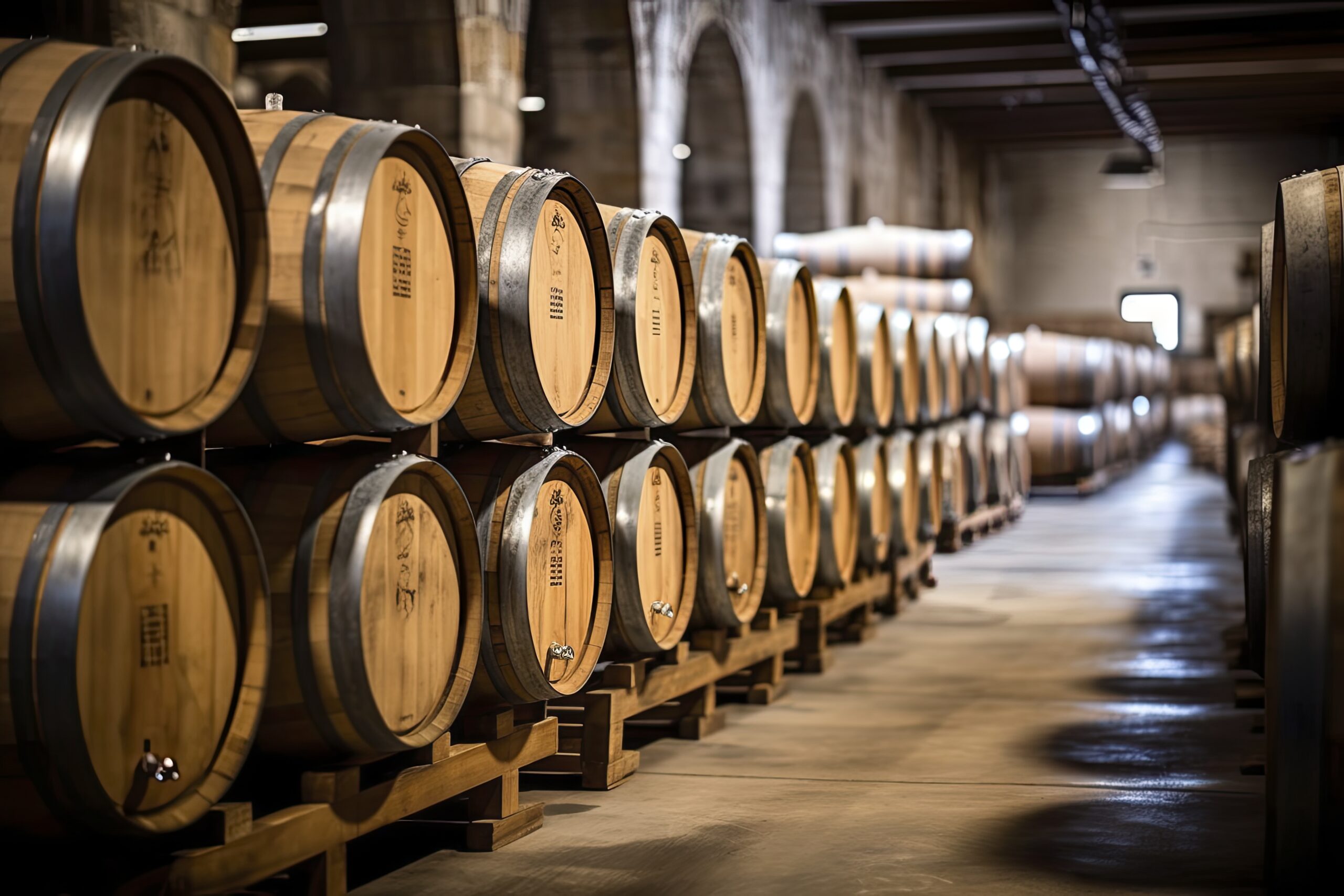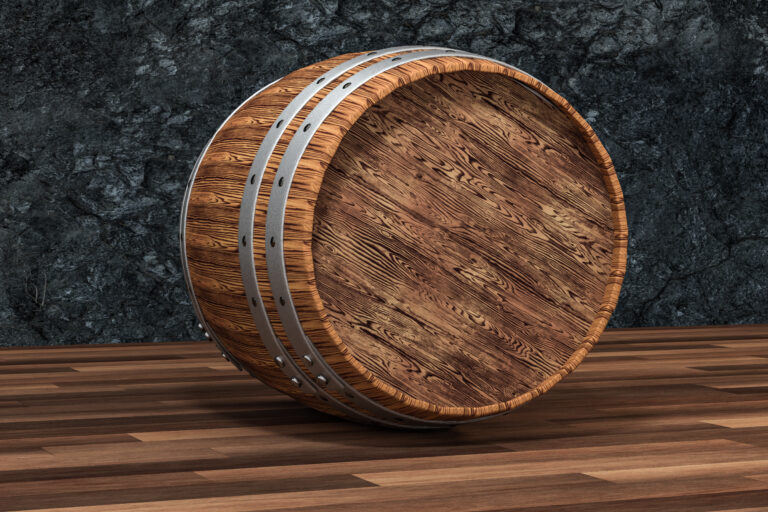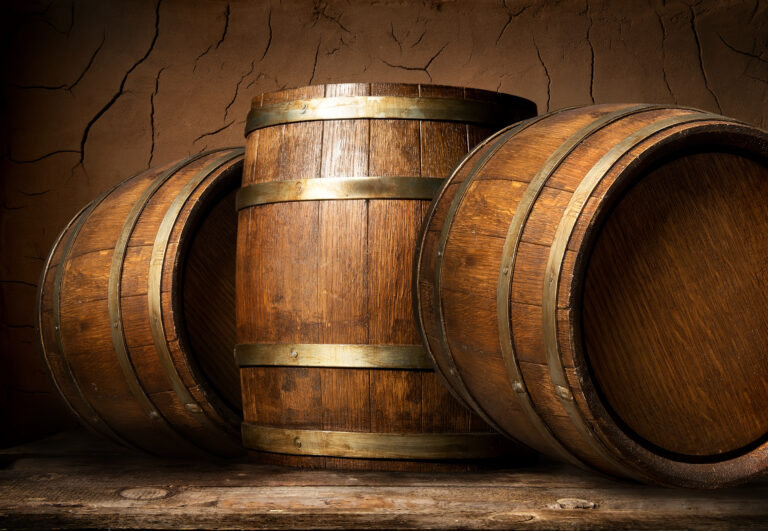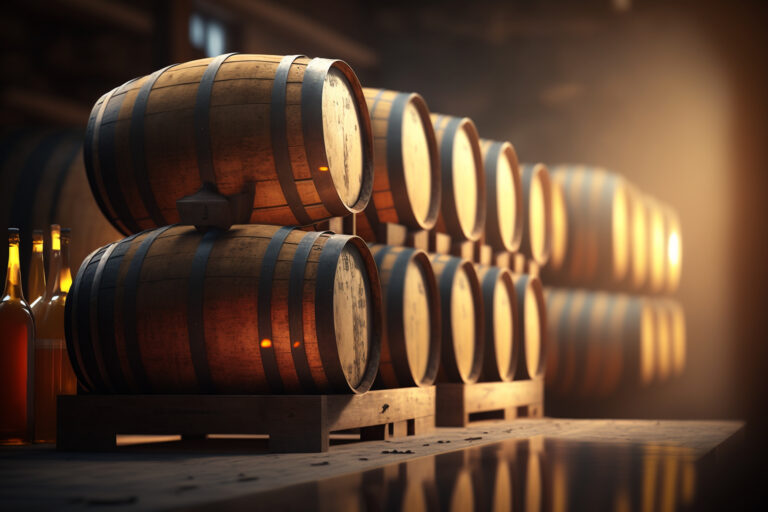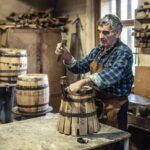Ever wondered about the unsung heroes behind your favorite aged spirits? It’s all about the barrel, my friend! For centuries, cooperages, or barrel makers, have been handcrafting these crucial vessels, passing down their secrets through generations. While many family-owned cooperages are sadly disappearing, a dedicated few are still keeping this traditional art alive. These skilled artisans transform raw oak staves into watertight barrels that lend distinct flavors and aromas to wines, whiskies, and other aged spirits. Their handmade barrels are coveted by premium producers for the complex character they help create.
Introduction to the Ancient Craft of Cooperage
Cooperage, the ancient craft of barrel making, has been around for ages. Skilled craftsmen, known as coopers, meticulously construct barrels to age and store wine, spirits, and ale. While most coopers today work in large, industrial-scale cooperages, a special handful of family-run cooperages are fiercely guarding these traditions.
These smaller cooperages painstakingly source the highest quality oak, typically French or American white oak, and custom-make barrels to perfectly suit each client’s needs. The coopers carefully split and shape the staves—those thin oak boards that form the barrel’s body. Then, they “raise the barrel,” carefully fitting steel or wooden hoops to hold the staves together.
Heating and Bending
Next, the cooper gently heats the assembled barrel over an open fire. This warmth softens the oak, allowing the staves to be expertly bent and shaped into that familiar circular form. As the wood cools, it holds its new rounded shape. More hoops are then added, along with a round wooden bottom—what’s called a head—at each end.
Toasting and Charring
Before those barrel heads are finally secured, the inside gets a special treatment: it’s toasted over an open flame. The level of toasting, from a light touch to a deep char, depends on what the barrel will be used for and the client’s preference. This toasted interior is where the magic happens, imparting those sought-after flavors to the liquid inside during aging.
Finally, with the barrel heads firmly in place, the barrel is ready to age wine, spirits, or ale, sometimes for many years! This patient process allows the natural transfer of the oak’s qualities into the liquid. While industrial cooperages chase volume, family cooperages pour their heart into crafting barrels for the best possible product. Their time-honored skill and personal touch make them absolutely essential to premium wineries, distilleries, and breweries worldwide.
A Brief History of Barrel-Making and Cooperages
Cooperages, the very workshops where barrels come to life, have graced our world for centuries. Many were family-owned, with the craft being lovingly passed down through generations. Sadly, most have vanished over time, though a few resilient stalwarts still stand.
Barrel-making first emerged in the Middle Ages, when wooden staves and metal hoops were ingeniously combined to create watertight casks. As the wine and spirits trade blossomed, coopers continually refined their craft. Master coopers guided apprentices, who dedicated years to learning how to select and prepare wood, shape staves, and assemble barrels with precision.
By the 1800s, oak from France and Eastern Europe was highly prized for the flavors it could impart to aging spirits. Coopers developed specific barrels for wines, cognacs, rums, and whiskies. Certain regions became renowned for barrels that uniquely enhanced particular spirits:
- The Limousin forests of France provided oak ideal for Cognac.
- The Slavonian oak of Croatia was sought after for aging Scotch whisky.
- American white oak gave bourbon its signature vanilla and caramel notes.
Skilled coopers continued to handcraft barrels through the mid-20th century. Then, costs soared, markets shifted, and production largely moved to factories. Yet, some small cooperages bravely persevered, still making barrels the traditional way for premium spirits.
Though labor-intensive and time-consuming, traditional coopering remains a true art form. When you savor a well-aged spirit, you’re not just tasting the liquid in your glass; you’re experiencing the wood of the barrel and the craft that shaped it. Centuries-old coopering traditions live on in every dram, connecting us to a rich history of barrel-making mastery. The surviving family cooperages deserve immense credit for keeping this cultural heritage vibrant. Their barrels are functional works of art in a world increasingly dominated by mass production. Here’s to the coopers and their enduring trade!
The Art and Science Behind Traditional Barrel Crafting
The craft of cooperage, or barrel making, has been meticulously perfected over centuries. Family-owned cooperages are fighting to stay relevant in today’s world of mass production, but their time-honored techniques produce barrels of truly unparalleled quality.
Selecting the Wood
The very foundation of a barrel’s flavor lies in the wood itself, typically oak. Cooperages thoughtfully select wood from forests known for yielding barrels that impart ideal aromas and tannins to the wine or spirit. This carefully chosen wood is then patiently aged and seasoned for at least two years before it’s transformed into barrels.
Heating and Bending
The staves, or planks of wood, are heated using a wood-burning furnace, making them pliable enough to bend into that familiar barrel shape. This stage demands an experienced cooper who knows just how to properly heat and bend each stave without scorching the precious wood.
Toasting the Barrels
The inside of the barrels are toasted using a gas torch, with the intensity and duration directly influencing the barrel’s impact on the flavor and aroma compounds of the contents. This step is a delicate blend of art and science, relying heavily on the cooper’s seasoned judgment and expertise.
Assembling and Shaping
The staves are meticulously assembled and secured with hoops—flat metal strips—and fitted with a plug, or bung. The cooper then uses specialized tools to precisely shape the barrel, ensuring an airtight seal and the perfect dimensions for aging its precious contents.
While mass-produced barrels might be more affordable and efficient to make, traditional craftsmanship results in barrels that impart richer, more complex flavors, truly enhancing wines and spirits. Family-owned cooperages bravely carrying on these time-honored traditions deserve our unwavering support to prevent the loss of this remarkable artisanal craft. The delicious results of their labors enrich our culture in ways both delightful and deeply satisfying.
Family-Owned Cooperages: Keeping the Tradition Alive
Family-owned cooperages are passionately committed to upholding time-honored traditions while also cleverly innovating to keep pace with modern demands. For generations, these dedicated craftsmen have been hand-making and repairing wooden barrels, meticulously preserving skills that stretch back centuries.
Maintaining History
Many family-run cooperages boast a history spanning over 100 years, with knowledge lovingly passed down from father to son. They prioritize quality and craftsmanship over mere mass production. Each barrel is a labor of love, carefully crafted by hand, utilizing techniques like “raising the barrel staves” over fire to expertly bend the wood.
Custom Creations
Family cooperages excel at crafting custom barrels to perfectly match a winery’s specific needs. They possess an intimate understanding of how factors like wood type, toast level, and barrel shape subtly influence the flavor of wine during aging. Wineries often forge deep, trusting partnerships with these coopers, confident their product is in expert hands.
Adapting to Change
While deeply respecting tradition, family cooperages have also wisely embraced new technologies and sustainable practices. Some now use specially-designed machines to reduce heavy lifting, alongside eco-friendly finishing methods. They’re also passing on their invaluable skills to the next generation, who bring fresh perspectives to the trade. These coopering families are living proof that heritage businesses can truly evolve and thrive in the modern world.
An Uncertain Future
There’s a genuine concern that traditional coopering might eventually fade away. Many young people are choosing different career paths, leaving a dwindling number of master coopers to carry on the craft. However, a growing appreciation for artisanal goods and a strong movement to support local businesses suggest a promising future for time-honored trades like coopering.
Family-run cooperages represent a vital link to our past, keeping alive woodworking skills that have been refined over generations. Simultaneously, they continue to improve their craft to create barrels precisely tailored to the needs of wineries, both today and tomorrow. With the unwavering dedication of these families, the ancient art of coopering proudly lives on.
Inside a Modern Cooperage: Tools, Techniques, and Skills
The tools and techniques used in traditional cooperages have been refined over generations, meticulously passed down through apprenticeships. While modern machinery has certainly made its way in, much of the work is still done by hand, demanding both incredible skill and sheer physical labor.
Staves and Hoops
The staves, those narrow strips of oak that form the barrel’s body, must be painstakingly shaped and fitted together. Hoops of wood or metal are then skillfully fitted around the outside of the staves to hold them firmly in place as the barrel is assembled.
Raising the Barrel
The staves are expertly assembled into that familiar barrel shape, with the wider ends positioned at the top and bottom. Ropes and hoops are then used to pull the staves tightly together, drawing the barrel into its beautifully rounded form. This step requires immense strength, precise coordination, and a deep understanding of how the wood will bend and flex.
Toasting and Charring
The inside of the barrel may be toasted or charred before use, a crucial step that helps shape the flavor of the barrel’s contents. The barrel is rotated over an open flame, with the intensity and duration precisely controlling how much the wood is toasted. Charring refers to a darker roast that produces distinctive smoky, caramelized flavors.
Checking for Leaks
Once assembled, the barrel must be rigorously checked for any leaks before it’s put to use. The cooper will fill the barrel with water and carefully roll and tilt it to meticulously check for any drips or trickles, making any necessary repairs to ensure a perfectly airtight seal.
The skills required to craft barrels have been cultivated for generations. While machinery has brought some efficiencies, human skill, judgment, and physical labor remain absolutely essential to this craft. The tradition of family-owned cooperages proudly lives on through the dedication of coopers around the globe.
Why Small Cooperages Still Matter in the Age of Mass Production
Small, family-owned cooperages might seem like a relic of the past, but they still play an incredibly vital role in the world of wine and spirits. While large cooperages churn out barrels on an industrial scale, these smaller, specialized shops offer some truly unique advantages.
Experience and Craftsmanship
Coopers at small cooperages typically dedicate many years to perfecting their craft. They gain invaluable knowledge, often passed down through generations, on how to carefully select wood and build barrels meticulously tailored to a customer’s exact needs. In contrast, large cooperages prioritize efficiency and standardization over individual craftsmanship.
Personalized Service
Instead of just being another order number, customers at small cooperages are treated like partners. They take the time to deeply understand how their barrels will be used and offer expert recommendations based on the type of wine or spirit, aging time, and desired flavor profile. They can even customize barrels upon request for a truly ideal match.
Sustainability
Small cooperages are often more likely to source wood from sustainable forests and actively support local economies. They don’t have the massive wood demand of large cooperages, allowing them to be far more selective. They also typically pay fair wages to the skilled coopers in their local community.
Tradition
For many wineries and distilleries, purchasing from a small, historic cooperage is incredibly appealing because it continues a rich, age-old tradition. Some cooperages have been family-owned for centuries and are practically institutions. Their barrels become an integral part of the story and terroir of the final product.
While the future of cooperages as a whole might lean towards large-scale production, small cooperages serve as a powerful reminder of the very roots of barrel-making. They preserve invaluable skills, sustainable practices, and deeply personal relationships that machine-made barrels simply can’t replicate. For these reasons, small cooperages still truly matter.
The Impact of Oak Types and Origins on Barrel Quality
The type of oak used and its precise origin significantly influence the quality and flavor of the barrels produced. The most prized oak types for barrel-making are Quercus alba (better known as American white oak) and Quercus petraea (or European oak).
American White Oak
American white oak has been the gold standard for barrel-making in the U.S. for centuries. It grows abundantly and sustainably in forests across the Eastern and Midwestern United States.
White oak barrels typically impart delightful aromas of vanilla, caramel, and coconut to wines and spirits. The wood itself is porous, allowing for a beneficial interaction between the liquid and the wood.
White oak staves need to be air-dried for at least 18-24 months to mellow the tannins in the wood before they’re crafted into barrels. This extended aging and mellowing process is absolutely key to creating barrels that won’t impart bitter or astringent flavors.
European Oak
Quercus petraea, or sessile oak, is highly valued for barrel making in France and other parts of Europe. It’s generally considered more tannic than American white oak.
European oak barrels tend to impart appealing aromas of clove, nutmeg, and cinnamon spice. They often require longer maturation periods—3 years or more—to truly soften the oak flavors.
European oak staves are frequently aged outdoors, exposed to environmental conditions that help speed up the mellowing process. Cooperages strive for a perfect balance: aging the staves to mellow the oak while still preserving some of its important tannic structure.
The origin and type of oak, combined with the cooper’s skill in crafting and toasting the barrels, create subtle but significant differences that shape the unique character of wines and spirits. For many distillers and winemakers, a thoughtful blend of barrels from different oak types and origins helps them achieve incredible complexity in their aged products. Despite the growing threat from larger commercial cooperages, traditional family-owned cooperages continue to preserve the artisanal craft of barrel-making for future generations. Their time-honored techniques and unwavering focus on sustainability truly set them apart.
Innovations in Barrel-Making: Blending Tradition With Technology
Cooperages that have been family-owned for generations are cleverly finding ways to adopt new technologies without compromising on quality or tradition. Many have discovered that blending tried-and-true barrel-making techniques with innovative tools and processes allows them to streamline production while still producing barrels with incredibly rich character.
Monitoring Barrel Aging
Some cooperages now utilize wireless sensors embedded directly in barrels to meticulously monitor factors like temperature, humidity, and the chemical processes unfolding inside the wood during aging. This invaluable data provides coopers with insights to make subtle adjustments that can enhance the barrel’s profound influence on the wine or spirit. Though a high-tech solution, it perfectly supports the cooperage’s time-honored pursuit of crafting the ideal barrel.
Toasting and Bending
Traditionally, barrel staves were bent using steam and sheer muscle power, and barrels were toasted over open flames. Today, many cooperages are embracing mechanical stave bending machines and convection or radiant heat for toasting. These modern tools boost efficiency and consistency, while coopers still oversee the entire process, making fine-tuned adjustments based on years of experience and personal preference.
Repair and Maintenance
Some family cooperages have even developed custom tools, like robotic systems, to quickly and precisely plane barrel staves. They also use machine-made metal hoops and bands instead of the handmade wooden hoops used traditionally. Instead of outsourcing repairs, some cooperages have built custom machines to repair small cracks and holes in barrels. This ingenious approach allows them to salvage barrels that would otherwise be discarded, continuing to provide long-lasting barrels to customers who have come to expect durability.
These kinds of innovations beautifully demonstrate how cooperages can thoughtfully and selectively blend new technologies with artisanal practices to not just preserve tradition, but to actually push the craft forward. Family-owned cooperages are finding ingenious ways to sustain and build upon their legacy for future generations through a harmonious balance of progress and timeless skill. By holding fast to quality and character above all else, these living pieces of history truly survive.
The Future of the Cooperage Trade: Can Family Businesses Survive?
The future of family-owned cooperages is, frankly, a bit uncertain. As consumers increasingly lean towards mass-produced and cheaper wine and spirits, the demand for high-quality, artisanal barrels has seen a decline. Many small cooperages have sadly been forced to close their doors over the past few decades. However, some are bravely finding innovative ways to sustain their historic craft.
Diversification
Some cooperages are wisely diversifying into areas like barrel alternatives, such as oak inserts that can be used in stainless steel tanks, or oak spirals and oak chips that can be added to wine during aging. These provide more affordable oak flavoring options for producers.
Focus on Quality
Other cooperages are doubling down on extremely high-quality, custom barrels to meet the specific demands of boutique wineries and distilleries who are always on the hunt for the best aging vessels. These barrels require the highest degree of skill and craftsmanship to produce, allowing these cooperages to command premium prices.
Educating Consumers
A few proactive cooperages have been working hard to build appreciation for the crucial role of barrels in producing fine wines and spirits. By helping people understand how barrel aging contributes to the unique flavor, aroma, and texture of artisanal products, they aim to increase the perceived value of barrels, which can translate into increased sales.
Niche Markets
Some cooperages have found success by specializing in unique, niche barrel types like large casks, clay amphorae, or barrels made from alternative wood species. These niche products attract customers looking for something truly distinctive that will impart a singular character to their wines or spirits.
While the future remains uncertain, a willingness to adapt, a laser focus on quality, and the exploration of niche opportunities may just allow more family-owned cooperages to continue their time-honored craft. With any luck, these small businesses can survive and even thrive, preserving a tradition that has been an integral part of winemaking and distillation for centuries.
Final Thoughts
So, what’s the verdict? Are family-owned cooperages a dying art or are they here to stay? Only time will tell, but as long as people continue to appreciate fine craftsmanship, deep-rooted tradition, and unwavering quality, there will likely always be a cherished place for these time-honored barrel makers. The next time you enjoy a bold Cabernet or a complex Chardonnay, raise your glass to the generations of coopers who helped make that possible. Their skills, lovingly passed down through families, connect us to centuries of history with every single sip. Coopering may be an old trade, but its contributions are still newfound joys waiting to be uncorked.
